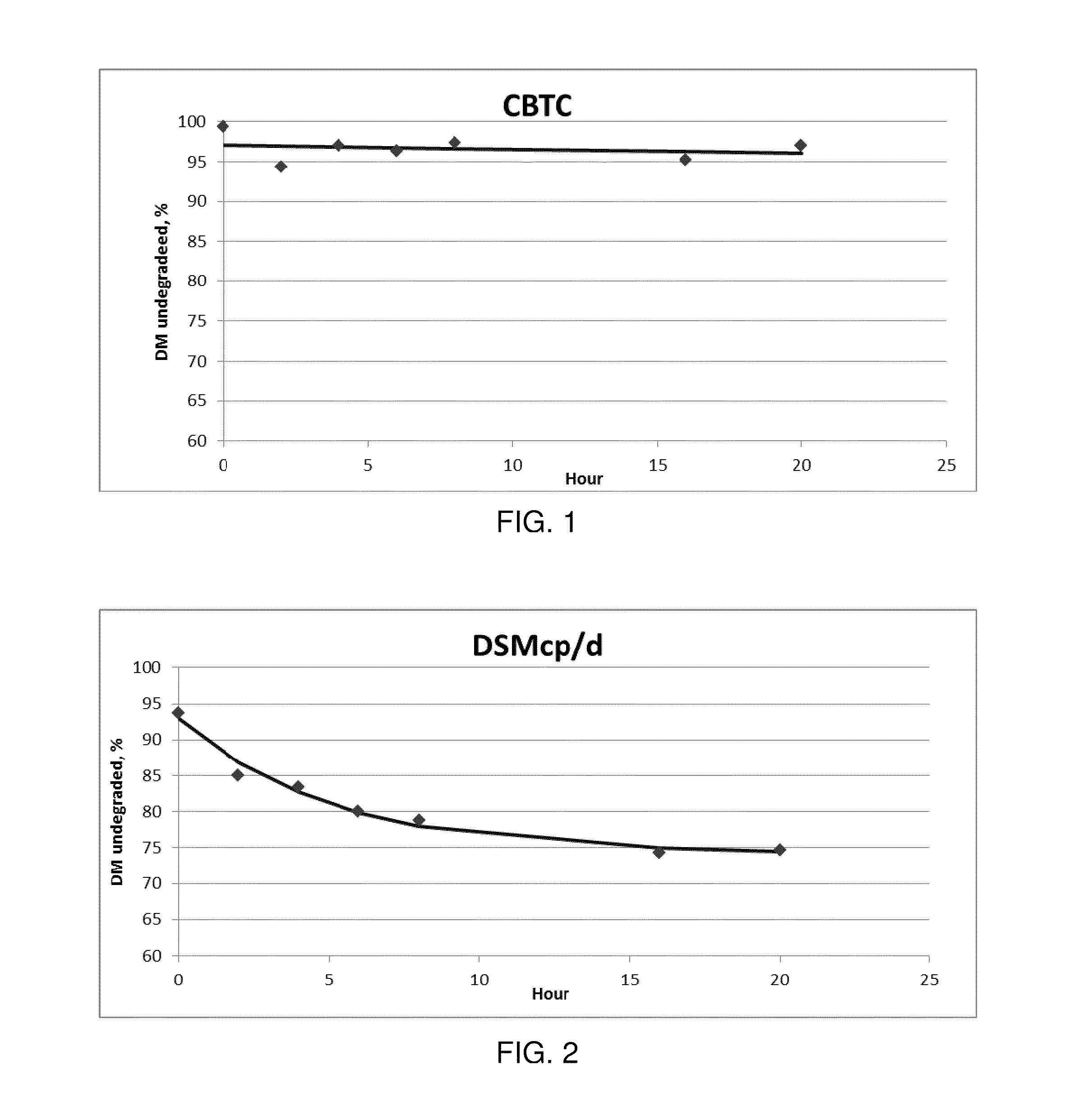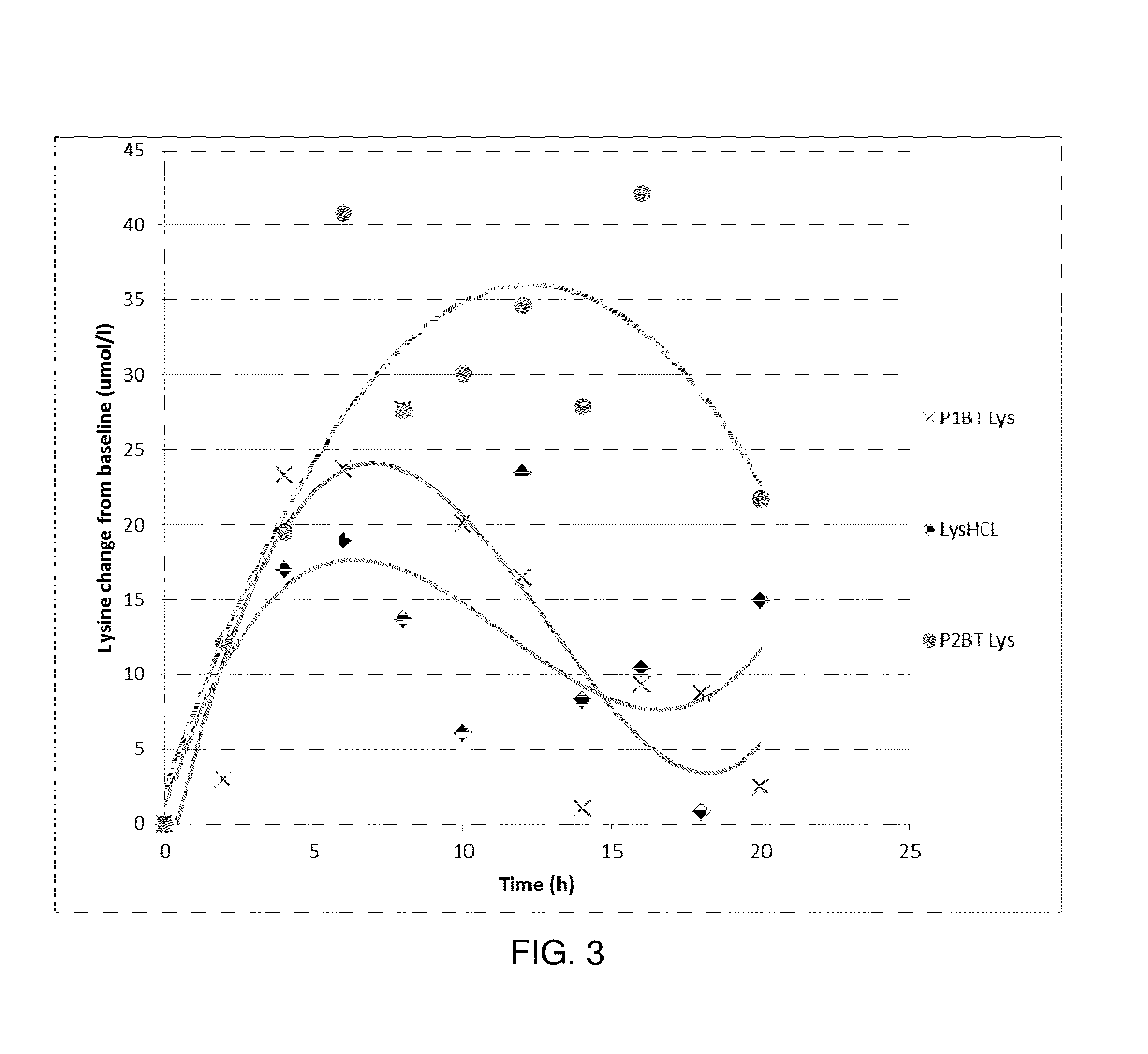Micro Particles for Oral Delivery in Animals
a technology of micro particles and oral delivery, applied in the field of compositions, can solve the problems of difficult solution of oral administration of active substances in the zoo, and the degradation is particularly substantial
- Summary
- Abstract
- Description
- Claims
- Application Information
AI Technical Summary
Benefits of technology
Problems solved by technology
Method used
Image
Examples
example 1
Controlled-Release Formulation Based on a Core that Contains Active Ingredients and Carboxylic Acid Intimately Mixed in it
Composition:
[0039]
CoreActive ingredientL-Lysine12.6kgmonohydrochloride(ADM, Decatur Illinois,USA)L-Lysine in aqueous2kgsolution at 50%(ADM, Decatur Illinois,USA)Carboxylic acidStearic acid2kg(BBC srl, Torre BoldoneBG, IT)Coating layerFatVegetoil S, hydrogenated4.4kgvegetable oil(BBC srl, Torre BoldoneBG, IT)
[0040]The dry L-lysine monohydrochloride was mixed with liquid basic L-Lysine and stearic acid at 70° C. in a ploughshare mixer for 30 minutes. The core was then cooled to 40° C. and the coating layer was applied at 65° C. by spraying it in a pan coater. The microparticles were then cooled under 45° C.
[0041]A release dissolution test was performed with a USP paddle apparatus (Apparatus 2) at 38° C. and 100 r.p.m, in 700 ml of distilled water.
[0042]After 24 hours the released L-lysine was 18.7% with a standard deviation of 0.8.
example 2
Controlled-Release Formulation Based on a Core that Contains Active Ingredients and Carboxylic Acid Added on their Surface
Composition:
[0043]
CoreActive ingredientsL-Lysine240.38kgmonohydrochloride(ADM, Decatur Illinois,USA)L-Lysine in aqueous9.62kgsolution at 50%(ADM, Decatur Illinois,USA)Carboxylic acidStearic acid44.6kg(BBC srl, TorreBoldone BG, IT)Coating layerVegetoil S,62.4kghydrogenated vegetableoil(BBC srl, TorreBoldone BG, IT)
[0044]The dry L-lysine monohydrochloride was mixed with liquid basic L-Lysine at 45° C. in a ribbon blender. The liquid was sprayed on the dry L-lysine monohydrochloride using a spraying nozzle at 2 barr pressure over a time of 5 minutes. The granules were then dried in a fluid bed. Stearic acid at 70° C. was added to the surface of the preformed microgranules by spraying it in a pan coater. The core was then cooled to 40° C. and the coating layer was applied at 65° C. by spraying it in a pan coater. The microparticles were then cooled under 45° C.
[0045]...
example 3
Use of an Excipient in the Coating Layer
[0047]Composition:
CoreActiveL-Lysine6523.8gingredientsmonohydrochloride(ADM, Decatur IL,USA)L-Lysine in aqueous476.2gsolution at 50%(ADM, Decatur, IL,USA)Carboxylic acidStearic acid1000g(BBC srl, TorreBoldone BG, IT)coating layerfatVegetoil S,1980ghydrogenatedvegetable oil(BBC srl, TorreBoldone BG, IT)excipientSoy lecithin20g
[0048]The dry L-lysine monohydrochloride was mixed with liquid L-lysine at 45° C. in a rotary granulating machine. The granules were then dried in a fluid bed. Stearic acid at 70° C. was added to the preformed microgranules by spraying it in a pan coater. The core was then cooled at 40° C. and coated at 65° C. with the liquid fat containing the lecithin. The microparticles were then cooled under 45° C.
[0049]A release dissolution test was performed with a USP paddle apparatus (Apparatus 2) at 38° C. and 100 r.p.m, in 700 ml of distilled water.
[0050]After 24 hours the released L-lysine was 13.8% with a standard deviation of ...
PUM
| Property | Measurement | Unit |
|---|---|---|
| Fraction | aaaaa | aaaaa |
| Fraction | aaaaa | aaaaa |
| Fraction | aaaaa | aaaaa |
Abstract
Description
Claims
Application Information
 Login to View More
Login to View More - R&D Engineer
- R&D Manager
- IP Professional
- Industry Leading Data Capabilities
- Powerful AI technology
- Patent DNA Extraction
Browse by: Latest US Patents, China's latest patents, Technical Efficacy Thesaurus, Application Domain, Technology Topic, Popular Technical Reports.
© 2024 PatSnap. All rights reserved.Legal|Privacy policy|Modern Slavery Act Transparency Statement|Sitemap|About US| Contact US: help@patsnap.com









